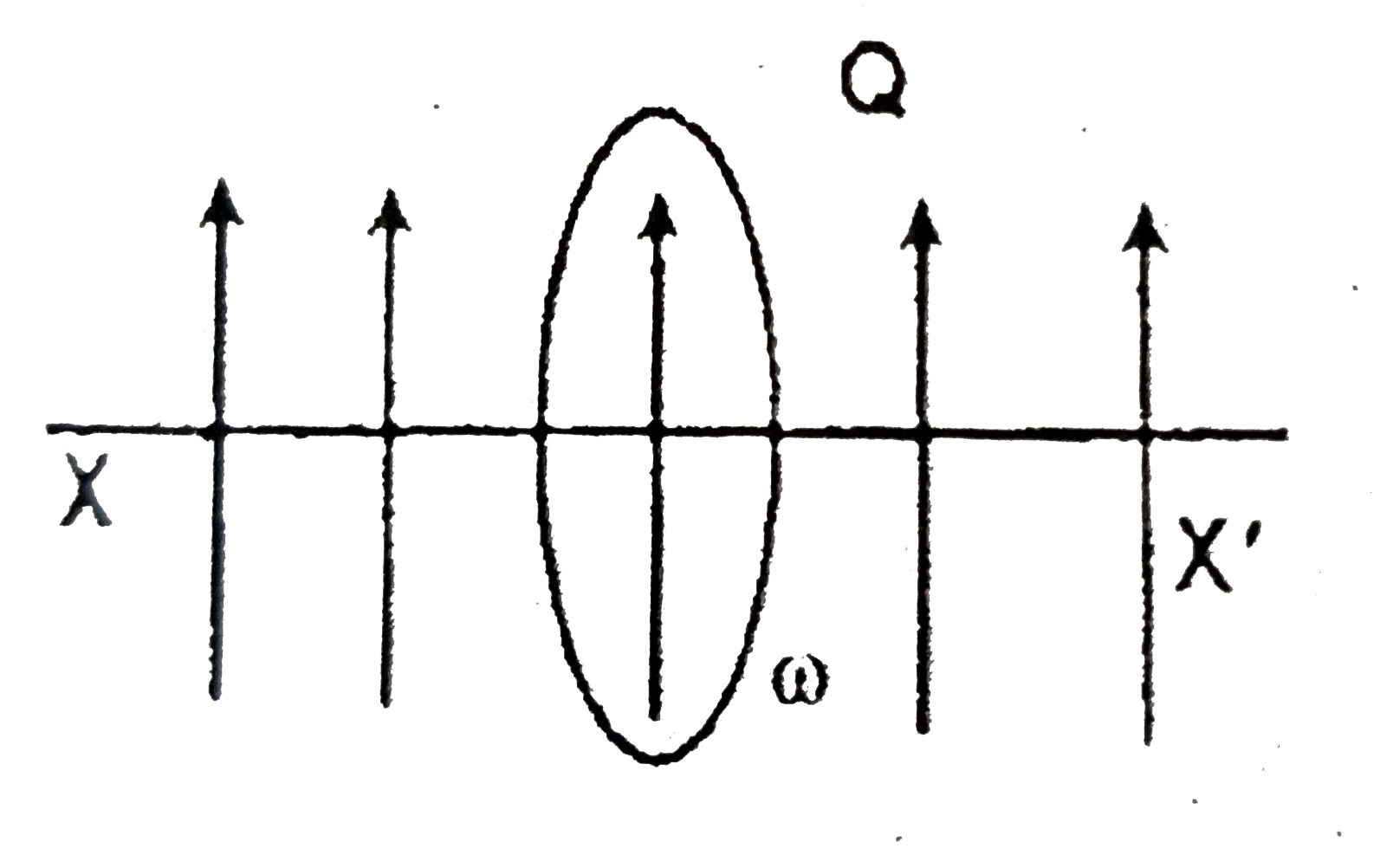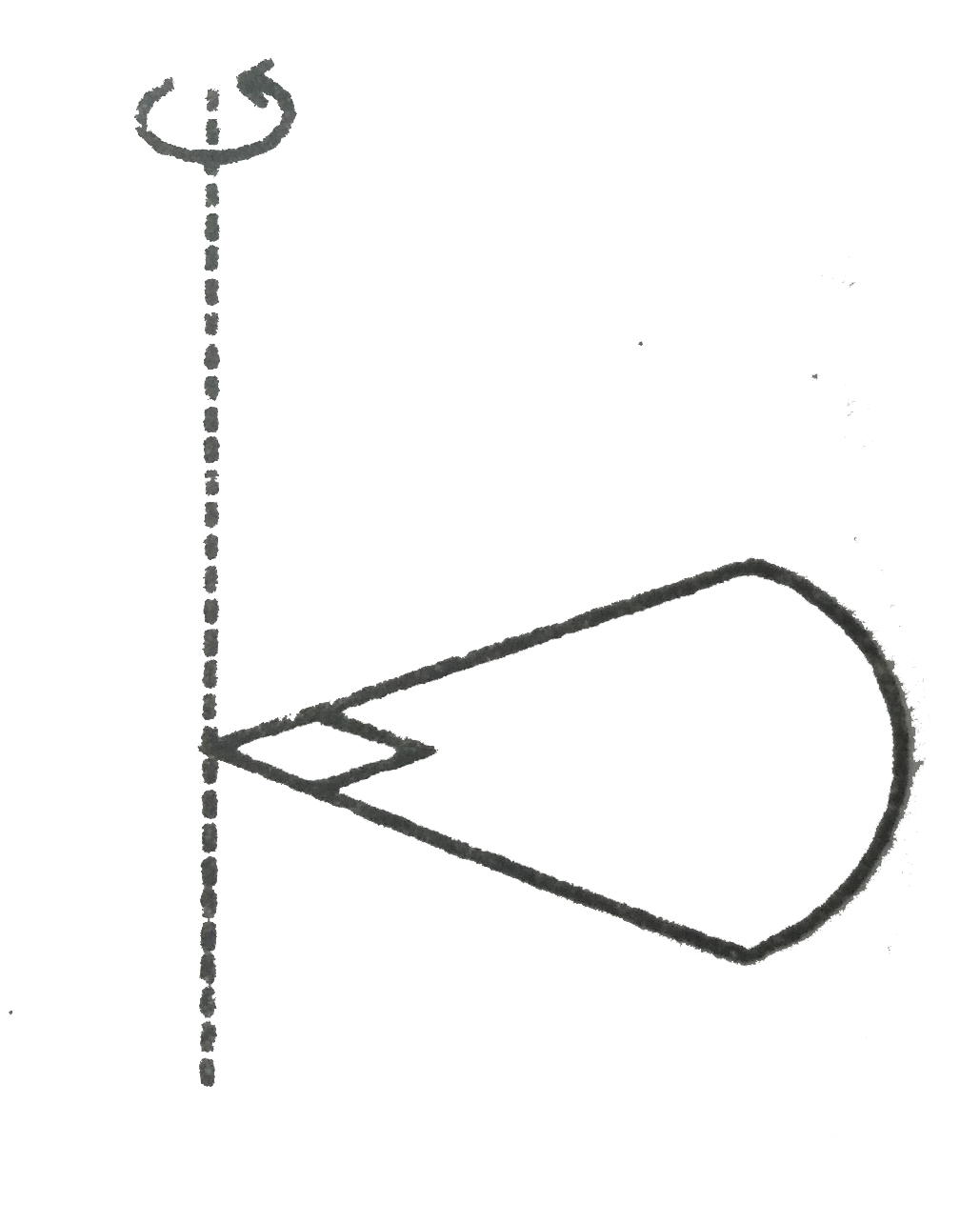A flat dielectric disc of radius R carries an exces charge on its surface. The surface charge density σ. The disc rotastes about an axis perpendicular to its lane passing thrugh the centre with angulasr velocity ω. Find the toruque on the disc if it is placed in a uniform magnetic field B directed perpendicular to the rotation axis.
To solve the problem of finding the torque on a rotating dielectric disc with a surface charge density in a magnetic field, we can follow these steps:
Step 1: Understanding the Setup
We have a flat dielectric disc of radius R with a surface charge density σ. The disc rotates about an axis perpendicular to its plane with an angular velocity ω. A uniform magnetic field B is directed perpendicular to the rotation axis.
Step 2: Consider a Differential Element
We consider a small circular ring of radius r and thickness dr on the disc. The area of this ring is given by:
dA=2πrdr
Step 3: Calculate the Charge on the Differential Element
The charge dq on this differential ring can be expressed in terms of the surface charge density:
dq=σdA=σ⋅(2πrdr)
Step 4: Determine the Current Due to Rotation
As the disc rotates, the charge dq contributes to a current I. The current can be defined as:
I=dqdt
The frequency of rotation f is related to the angular velocity ω by:
f=ω2π
Thus, the current I through the ring becomes:
I=dq⋅f=σ(2πrdr)⋅ω2π=σωrdr
Step 5: Calculate the Torque on the Differential Element
The torque dτ on the differential ring in the magnetic field B can be calculated using the formula:
dτ=m⋅B⋅sin(θ)
Since the magnetic field is perpendicular to the plane of the disc, θ=90∘ and sin(90∘)=1. The mass m of the current loop can be expressed as:
m=n⋅I⋅A
where n=1 for a single loop, I is the current we calculated, and A is the area of the ring:
dτ=I⋅(2πrdr)⋅B
Substituting for I:
dτ=(σωrdr)⋅(2πr)⋅B=2πσωr2Bdr
Step 6: Integrate to Find Total Torque
To find the total torque τ on the entire disc, we integrate dτ from r=0 to r=R:
τ=∫R0dτ=∫R02πσωr2Bdr
Calculating the integral:
τ=2πσωB∫R0r2dr=2πσωB(r33)R0=2πσωB⋅R33
Final Result
Thus, the total torque on the disc is:
τ=2πσωBR33
We have a flat dielectric disc of radius R with a surface charge density σ. The disc rotates about an axis perpendicular to its plane with an angular velocity ω. A uniform magnetic field B is directed perpendicular to the rotation axis.
We consider a small circular ring of radius r and thickness dr on the disc. The area of this ring is given by:
dA=2πrdr
The charge dq on this differential ring can be expressed in terms of the surface charge density:
dq=σdA=σ⋅(2πrdr)
As the disc rotates, the charge dq contributes to a current I. The current can be defined as:
I=dqdt
The frequency of rotation f is related to the angular velocity ω by:
f=ω2π
Thus, the current I through the ring becomes:
I=dq⋅f=σ(2πrdr)⋅ω2π=σωrdr
The torque dτ on the differential ring in the magnetic field B can be calculated using the formula:
dτ=m⋅B⋅sin(θ)
Since the magnetic field is perpendicular to the plane of the disc, θ=90∘ and sin(90∘)=1. The mass m of the current loop can be expressed as:
m=n⋅I⋅A
where n=1 for a single loop, I is the current we calculated, and A is the area of the ring:
dτ=I⋅(2πrdr)⋅B
Substituting for I:
dτ=(σωrdr)⋅(2πr)⋅B=2πσωr2Bdr
To find the total torque τ on the entire disc, we integrate dτ from r=0 to r=R:
τ=∫R0dτ=∫R02πσωr2Bdr
Calculating the integral:
τ=2πσωB∫R0r2dr=2πσωB(r33)R0=2πσωB⋅R33
Thus, the total torque on the disc is:
τ=2πσωBR33
Topper's Solved these Questions
- MAGNETICSBOOK - DC PANDEY ENGLISHCHAPTER - MAGNETICSEXERCISE - INTRODUCTORY EXERCISE
1 Video
- MAGNETICSBOOK - DC PANDEY ENGLISHCHAPTER - MAGNETICSEXERCISE - SUBJECTIVE_TYPE
1 Video
- MAGNETIC FIELD AND FORCESBOOK - DC PANDEY ENGLISHCHAPTER - MAGNETIC FIELD AND FORCESEXERCISE - Medical entrance s gallery
59 Videos
- MAGNETISM AND MATTERBOOK - DC PANDEY ENGLISHCHAPTER - MAGNETISM AND MATTEREXERCISE - Medical gallery
1 Video
Similar Questions
A ring of mass m and radius r rotates about an axis passing through its centre and perpendicular to its plane with angular velocity ω. Its kinetic energy is
View SolutionA disc of mass m has a charge Q distributed on its surface. It is rotating about an XX' with a angular velocity ω. The force acting on the disc is

View Solution
Knowledge Check
One quarter sector is cut from a uniform circular disc of radius R. The sector has mass M. IT is made to rotate about a line perpendicular to its plane and passing through the centre of the original disc. Its moment of inertia about the axis of rotation is
AMR2/2BMR2/4CMR2/8D√2MR2
A sphere of radius R, uniformly charged with the surface charge density σ rotates around the axis passing through its centre at an angular velocity. (a) Find the magnetic induction at the centre of the rotating sphere. (b) Also, find its magnetic moment.
View SolutionA charge Q is uniformly distributed over the surface of non - conducting disc of radius R. The disc rotates about an axis perpendicular to its plane and passing through its centre with an angular to its plane and passing through its centre of the disc. If we keep both the amount of charge placed on the disc and its angular velocity to be constant and vary the radius of the disc then the variation of the magnetic induction at the centre of the disc will br represented by the figure:
View SolutionA nonconducing disc of radius R is rotaing about axis passing through its cente and perpendicual its plance with an agular velocity ω . The magnt moment of this disc is .
View SolutionOne quarter sector is cut from a uniform circular disc of radius R. This sector has mass M. It is made to rotate about a line perpendicular to its plane and passing through the centre of the original disc. It moment of inertia about the axis of rotation is.
 .
.
View SolutionCircular disc of mass 2 kg and radius 1 m is rotating about an axis perpendicular to its plane and passing through its centre of mass with a rotational kinetic energy of 8 J. The angular momentum is (Js) is
View SolutionA metal disc of radius R rotates with an angular velcoity ω about an axis perpendiclar to its plane passing through its centre in a magnetic field B acting perpendicular to the plane of the disc. Calculate the induced emf between the rim and the axis of the disc.
View SolutionThe moment of inertia of a copper disc, rotating about an axis passing through its centre and perpendicular to its plane
View Solution
